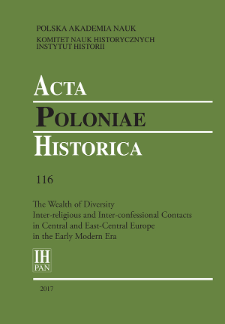- Search in all Repository
- Literature and maps
- Archeology
- Mills database
- Natural sciences
Advanced search
Advanced search
Advanced search
Advanced search
Advanced search

Object
Title: The Space of Power : State Consolidation by Means of Religious Policy in the Danube Principalities in the Fourteenth to Sixteenth Centuries
Subtitle:
Acta Poloniae Historica T. 116 (2017) ; The Wealth of Diversity Inter-religious and Inter-confessional Contacts in Central and East-Central Europe in the Early Modern Era
Contributor:
Hartzell, James : Ed. ; Institute of History of the Polish Academy of Sciences ; Polish National Historical Committee
Publisher:
Instytut Historii Polskiej Akademii Nauk
Place of publishing:
Description:
Type of object:
Abstract:
This article shows the close link between religious policy, especially that of the confessional option, and the politicization of space in the building processes of territorial states. The study focuses on the two Danube Principalities of Wallachia and Moldavia, which implemented their state building owing to three decisive steps: i) the jurisdictional option in favour of the Ecumenical Patriarchate in Constantinople; ii) the territorial and social implementation of the Byzantine Orthodox faith by institutional infrastructure and monastic reform; iii) the Orthodox enculturation of the two Wallachian principalities.The main goal of this chapter is to show how cultural and historical phenomena transform the abstract geographical space into the political space of a state.
References:
Grigore Mihai-D., ‘Von Papisten, Schismatikern und Ketzern. Der Donau-KarpatenRaum als Konfliktfeld konfessioneller Geschichtspolitik im 16. und 17. Jahrhundert’, Jahrbuch des Bundesinstituts für Kultur und Geschichte der Deutschen im Östlichen Europa, xxiii (2015), 21–31.
Grigore Mihai-D., ‘Zwischen orthodoxer Konformität und politischem Pragmatismus: Die Walachei im 16. Jahrhundert’, in Religion und Politik. Eine Quellenanthologie zu gesellschaftlichen Konjunkturen in der Neuzeit, ed. by Leibniz Institute of European History, [Accessed: 8 Nov. 2017].
Lefebvre Henri, The Production of Space, trans. by Donald Nicholson-Smith (Oxford and Cambridge MA, 1991).
Papacostea Șerban, Between the Crusade and the Mongol Empire. The Romanians in the 13th century (Bucharest, 1998).
Popescu Emilian and Căţoi Mihai O. (eds.), Istorie bisericească, misiune creștină și viaţă culturală II. Creștinismul românesc și organizarea bisericească în secolele XIII–XIV (Galaţi, 2010).
Pilat Liviu, Studii privind relaţiile Moldovei cu Sfântul Scaun și Patriarhia Ecumenică (secolele XIV–XVI) (Iași, 2012).
Rezachevici Constantin, Istoria popoarelor vecine și neamul românesc în Evul Mediu (Bucharest, 1998).
Turcuș Șerban, Sfântul Scaun și românii în secolul al XIII-lea (Bucharest, 2001).
Relation:
Volume:
Start page:
End page:
Detailed Resource Type:
Format:
Resource Identifier:
oai:rcin.org.pl:68564 ; 0001-6829 ; 10.12775/APH.2017.116.02
Source:
IH PAN, sygn. A.295/116 Podr. ; IH PAN, sygn. A.296/116 ; click here to follow the link
Language:
Rights:
Creative Commons Attribution BY-ND 4.0 license
Terms of use:
Copyright-protected material. [CC BY-ND 4.0] May be used within the scope specified in Creative Commons Attribution BY-ND 4.0 license, full text available at: ; -
Digitizing institution:
Institute of History of the Polish Academy of Sciences
Original in:
Library of the Institute of History PAS
Projects co-financed by:
Access:
Object collections:
- Digital Repository of Scientific Institutes > Partners' collections > Institute of History PAS > Serials
- Digital Repository of Scientific Institutes > Partners' collections > Institute of History PAS > Institute Publications
- Digital Repository of Scientific Institutes > Partners' collections > Institute of History PAS > Institute Publications > Journals
- Digital Repository of Scientific Institutes > Partners' collections > Institute of History PAS > Institute Publications > Journals > Acta Poloniae Historica
- Digital Repository of Scientific Institutes > Literature > Journals/Articles
Last modified:
Sep 22, 2023
In our library since:
Feb 18, 2019
Number of object content downloads / hits:
340
All available object's versions:
https://rcin.org.pl./publication/85768
Show description in RDF format:
Show description in RDFa format:
Show description in OAI-PMH format:
Objects Similar
Engelking, Anna (1959– )
Nandriş, Grigore (1895–1968)
Cieśla, Maria
Witt, Christian Volkmar (1980– )
Wawryszuk, Paweł
Bogucka, Maria (1929–2020)

 INSTYTUT ARCHEOLOGII I ETNOLOGII POLSKIEJ AKADEMII NAUK
INSTYTUT ARCHEOLOGII I ETNOLOGII POLSKIEJ AKADEMII NAUK
 INSTYTUT BADAŃ LITERACKICH POLSKIEJ AKADEMII NAUK
INSTYTUT BADAŃ LITERACKICH POLSKIEJ AKADEMII NAUK
 INSTYTUT BADAWCZY LEŚNICTWA
INSTYTUT BADAWCZY LEŚNICTWA
 INSTYTUT BIOLOGII DOŚWIADCZALNEJ IM. MARCELEGO NENCKIEGO POLSKIEJ AKADEMII NAUK
INSTYTUT BIOLOGII DOŚWIADCZALNEJ IM. MARCELEGO NENCKIEGO POLSKIEJ AKADEMII NAUK
 INSTYTUT BIOLOGII SSAKÓW POLSKIEJ AKADEMII NAUK
INSTYTUT BIOLOGII SSAKÓW POLSKIEJ AKADEMII NAUK
 INSTYTUT CHEMII FIZYCZNEJ PAN
INSTYTUT CHEMII FIZYCZNEJ PAN
 INSTYTUT CHEMII ORGANICZNEJ PAN
INSTYTUT CHEMII ORGANICZNEJ PAN
 INSTYTUT FILOZOFII I SOCJOLOGII PAN
INSTYTUT FILOZOFII I SOCJOLOGII PAN
 INSTYTUT GEOGRAFII I PRZESTRZENNEGO ZAGOSPODAROWANIA PAN
INSTYTUT GEOGRAFII I PRZESTRZENNEGO ZAGOSPODAROWANIA PAN
 INSTYTUT HISTORII im. TADEUSZA MANTEUFFLA POLSKIEJ AKADEMII NAUK
INSTYTUT HISTORII im. TADEUSZA MANTEUFFLA POLSKIEJ AKADEMII NAUK
 INSTYTUT JĘZYKA POLSKIEGO POLSKIEJ AKADEMII NAUK
INSTYTUT JĘZYKA POLSKIEGO POLSKIEJ AKADEMII NAUK
 INSTYTUT MATEMATYCZNY PAN
INSTYTUT MATEMATYCZNY PAN
 INSTYTUT MEDYCYNY DOŚWIADCZALNEJ I KLINICZNEJ IM.MIROSŁAWA MOSSAKOWSKIEGO POLSKIEJ AKADEMII NAUK
INSTYTUT MEDYCYNY DOŚWIADCZALNEJ I KLINICZNEJ IM.MIROSŁAWA MOSSAKOWSKIEGO POLSKIEJ AKADEMII NAUK
 INSTYTUT PODSTAWOWYCH PROBLEMÓW TECHNIKI PAN
INSTYTUT PODSTAWOWYCH PROBLEMÓW TECHNIKI PAN
 INSTYTUT SLAWISTYKI PAN
INSTYTUT SLAWISTYKI PAN
 SIEĆ BADAWCZA ŁUKASIEWICZ - INSTYTUT TECHNOLOGII MATERIAŁÓW ELEKTRONICZNYCH
SIEĆ BADAWCZA ŁUKASIEWICZ - INSTYTUT TECHNOLOGII MATERIAŁÓW ELEKTRONICZNYCH
 MUZEUM I INSTYTUT ZOOLOGII POLSKIEJ AKADEMII NAUK
MUZEUM I INSTYTUT ZOOLOGII POLSKIEJ AKADEMII NAUK
 INSTYTUT BADAŃ SYSTEMOWYCH PAN
INSTYTUT BADAŃ SYSTEMOWYCH PAN
 INSTYTUT BOTANIKI IM. WŁADYSŁAWA SZAFERA POLSKIEJ AKADEMII NAUK
INSTYTUT BOTANIKI IM. WŁADYSŁAWA SZAFERA POLSKIEJ AKADEMII NAUK




































